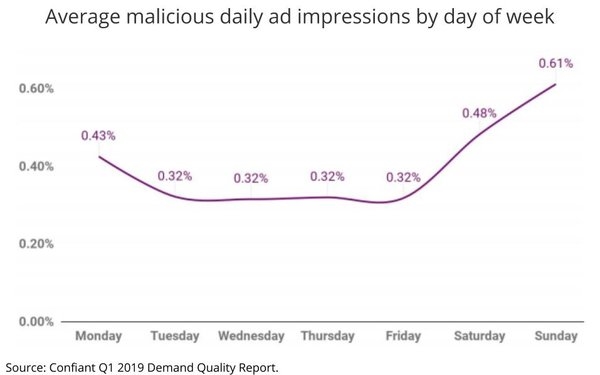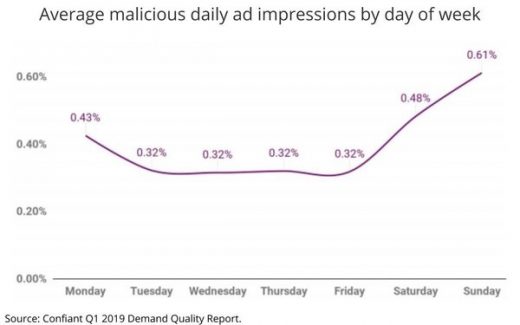Malvertising Found In 1 In Every 100 Ad Impressions
Malvertising Found In 1 In Every 100 Ad Impressions

Memorial Day could be the date of the next online advertising attack.
Weekends and holidays experience higher rates of malvertising attacks in the U.S., according to data released by Confiant, an ad security company. The data shows that the largest spike in malicious ads in the first quarter of 2019 occurred during the three-day U.S. federal holiday President’s Day.
Confiant, an ad security company, released data that benchmark quality issues publishers and platforms face, such as malicious ads, low-quality ads and in-banner video ads. The findings in the Demand Quality Report for Q1 2019 aim to help advertisers protect their reputation, revenue and resources. While there was a significant decrease in issues across all three categories, malicious and disruptive ads still impact nearly one in every 100 ad impressions. The study was conducted between the fourth quarter in 2018 and the first quarter in 2019.
The report also found that nearly 1 in every 100 ads was impacted by a malicious or disruptive ad. This statistic, when combined with an estimate of 4 to 5 display ads per page and 5 pages per session, suggests that more than 20% of user sessions might be impacted by malicious or disruptive ads.
It turns out that some supply-side platforms (SSPs) are 67 times as likely to deliver a malicious or disruptive ad. And, more than 60% of in-banner video ads and 60% of security issues came from just three SSPs.
In-banner video violations were high during the time period analyzed for the three SSPs. All showed, however, a significant decrease for in-banner video violations from the fourth quarter in 2018 to the first quarter in 2019. This across-the-board decline suggests system-wide factors more so than changes in internal standards on the part of the SSPs.
Seasonality also is a factor for the drop. The Confiant data also suggests that adoption of ads.txt also could be a factor. Ads.txt allows publishers to publicly identify who is authorized to sell their inventor. Increased adoption is eliminating unauthorized resellers, reducing their ability to exploit video-to-display arbitrage opportunities.
On a positive note, Confiant did observe a decrease in the violation rates from the fourth quarter of 2018 to the first quarter of 2019, and uncovered seasonal factors influencing industry-wide trends.
(20)


